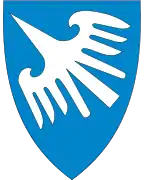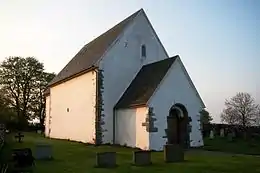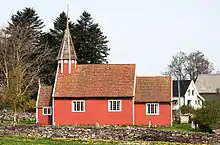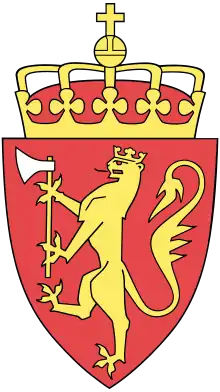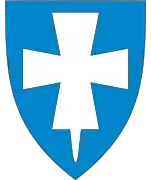Finnøy
Finnøy is a former municipality in Rogaland county, Norway. The 104 square kilometres (40 sq mi) island municipality existed from 1838 until its dissolution in 2020 when it was merged into Stavanger Municipality. It was located in the traditional district of Ryfylke. The administrative centre of the municipality was the village of Judaberg.
Finnøy kommune | |
|---|---|
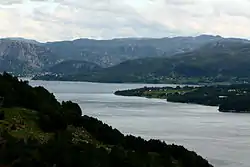 View of the shorelines of Ombo in Finnøy | |
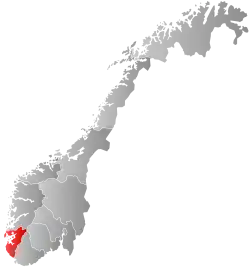 Rogaland within Norway | |
 Finnøy within Rogaland | |
| Coordinates: 59°09′53″N 05°49′46″E | |
| Country | Norway |
| County | Rogaland |
| District | Ryfylke |
| Established | 1 Jan 1838 |
| Disestablished | 1 Jan 2020 |
| Administrative centre | Judaberg |
| Government | |
| • Mayor (2015-2019) | Henrik Halleland (KrF) |
| Area | |
| • Total | 104.39 km2 (40.31 sq mi) |
| • Land | 102.90 km2 (39.73 sq mi) |
| • Water | 1.49 km2 (0.58 sq mi) |
| Area rank | 375 in Norway |
| *Area at municipal dissolution. | |
| Population (2017) | |
| • Total | 3,235 |
| • Rank | 256 in Norway |
| • Density | 31.4/km2 (81/sq mi) |
| • Change (10 years) | 21.1% |
| Demonym(s) | Finnøybu[1] |
| Time zone | UTC+01:00 (CET) |
| • Summer (DST) | UTC+02:00 (CEST) |
| ISO 3166 code | NO-1141 |
| Official language form | Nynorsk[2] |
| Created as | Formannskapsdistrikt in 1838 |
| Succeeded by | Stavanger in 2020 |
| Website | finnoy |
The municipality consisted of a number of islands on the south side of the Boknafjorden, about 24 kilometres (15 mi) northeast of the city of Stavanger. The Finnøy Tunnel connects the two islands of Finnøy and Talgje to the mainland. The rest of the islands are accessible only by boat.
Finnøy is an agricultural community dominated by dairy, meat, poultry, and fish farming products, with strong horticultural traditions, mainly greenhouse production of tomatoes, as well as some tourism.
Prior to its dissolution in 2020, the 104-square-kilometre (40 sq mi) municipality is the 375th largest by area out of the 422 municipalities in Norway. Finnøy was the 256th most populous municipality in Norway with a population of 3,235. The municipality's population density was 31.4 inhabitants per square kilometre (81/sq mi) and its population has increased by 21.1% over the last decade.[3]
General information
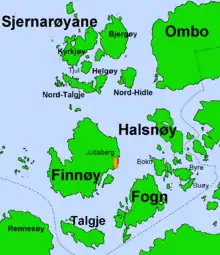
The parish of Finnø was established as a municipality on 1 January 1838 (see formannskapsdistrikt law). It originally encompassed the islands of Finnøy, Talgje, and Fogn as well as the small surrounding islets and the southeasternmost corner of the island of Rennesøy. On 1 January 1918, the part of Finnøy located on the island of Rennesøy (population: 72) was transferred from Finnøy to the neighboring municipality of Rennesøy.
During the 1960s, there were many municipal mergers across Norway due to the work of the Schei Committee. On 1 January 1965, the municipality of Finnøy was enlarged when it was merged with the entire municipality of Sjernarøy (population: 819), the northeastern part of Ombo island (population: 89) from the municipality of Jelsa, and the Fisterøyene islands (population: 246) from the municipality of Fister.[4]
On 1 January 2020, the municipalities of Finnøy, Rennesøy, and Stavanger were merged into one, large municipality called Stavanger.[5]
Name
The municipality is named after the island of Finnøy (Old Norse: Finnøy). The meaning of the first element is unknown and the last element is øy which means "island." Before 1918, the name was written "Finnø."[6]
Coat of arms
The coat of arms was granted on 23 September 1983. Despite its recent adoption, it has old roots. The arms show a silver or white wing on a blue background. The arms were derived from the arms of the Hestbø family (which included Ogmund Finnsson), one of the mightiest families in the area in the 14th century. They had their stronghold on their Hesby estate on the island of Finnøy in the present municipality.[7]
Churches
The Church of Norway has three parishes (sokn) within the municipality of Finnøy. It is part of the Tungenes prosti (deanery) in the Diocese of Stavanger.
| Parish (sokn) | Church name | Location of the church | Year built |
|---|---|---|---|
| Hesby | Hesby Church | Hesby on Finnøy | c. 1100 |
| Sjernarøy | Sjernarøy Church | Kyrkjøy in Sjernarøyane islands | 1647 |
| Jørstad Church | Jørstadvågen on Ombo | 1929 | |
| Talgje | Fogn Church | Fogn | 1991 |
| Talgje Church | Talgje | c. 1100 |
History
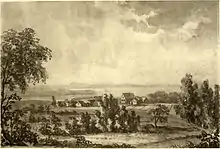

Finnøy was at the top of its power in the middle of the fourteenth century when the King's representative Ogmund Finnsson had his seat at Hesby on the west side of the island of Finnøy. The medieval, stone Hesby Church, dating back to at least the thirteenth century, still stands at Hesby.
It is often claimed that the Norwegian mathematician Niels Henrik Abel (1802–1829) was born on Finnøy, since his father Søren Georg acted as rector there. Recent studies indicates, however, that he was born in Nedstrand, a nearby parish. However, he was raised on Finnøy.
Geography
The island municipality of Finnøy is located on the south side of the Boknafjorden. The main islands of Finnøy include Finnøy, Talgje, Fogn, Halsnøya, Sjernarøyane, and the north and west parts of the island of Ombo. The islands of Talgje and Finnøy are connected to the mainland by the undersea Finnøy Tunnel. The rest of the islands are only accessible by boats.
Government
All municipalities in Norway, including Finnøy, are responsible for primary education (through 10th grade), outpatient health services, senior citizen services, unemployment and other social services, zoning, economic development, and municipal roads. The municipality is governed by a municipal council of elected representatives, which in turn elect a mayor.[8] The municipality falls under the Ryfylke District Court and the Gulating Court of Appeal.
Municipal council
The municipal council (Kommunestyre) of Finnøy was made up of 21 representatives that were elected to four year terms. The party breakdown for the councils was as follows:
| Party Name (in Nynorsk) | Number of representatives | |
|---|---|---|
| Labour Party (Arbeidarpartiet) | 2 | |
| Conservative Party (Høgre) | 4 | |
| Christian Democratic Party (Kristeleg Folkeparti) | 6 | |
| Centre Party (Senterpartiet) | 4 | |
| Liberal Party (Venstre) | 5 | |
| Total number of members: | 21 | |
| Party Name (in Nynorsk) | Number of representatives | |
|---|---|---|
| Labour Party (Arbeidarpartiet) | 3 | |
| Progress Party (Framstegspartiet) | 1 | |
| Conservative Party (Høgre) | 3 | |
| Christian Democratic Party (Kristeleg Folkeparti) | 5 | |
| Centre Party (Senterpartiet) | 4 | |
| Socialist Left Party (Sosialistisk Venstreparti) | 1 | |
| Liberal Party (Venstre) | 4 | |
| Total number of members: | 21 | |
| Party Name (in Nynorsk) | Number of representatives | |
|---|---|---|
| Labour Party (Arbeidarpartiet) | 1 | |
| Progress Party (Framstegspartiet) | 2 | |
| Conservative Party (Høgre) | 3 | |
| Christian Democratic Party (Kristeleg Folkeparti) | 7 | |
| Centre Party (Senterpartiet) | 6 | |
| Socialist Left Party (Sosialistisk Venstreparti) | 1 | |
| Liberal Party (Venstre) | 1 | |
| Total number of members: | 21 | |
| Party Name (in Nynorsk) | Number of representatives | |
|---|---|---|
| Labour Party (Arbeidarpartiet) | 1 | |
| Progress Party (Framstegspartiet) | 2 | |
| Conservative Party (Høgre) | 3 | |
| Christian Democratic Party (Kristeleg Folkeparti) | 7 | |
| Centre Party (Senterpartiet) | 6 | |
| Socialist Left Party (Sosialistisk Venstreparti) | 1 | |
| Liberal Party (Venstre) | 1 | |
| Total number of members: | 21 | |
| Party Name (in Nynorsk) | Number of representatives | |
|---|---|---|
| Labour Party (Arbeidarpartiet) | 2 | |
| Progress Party (Framstegspartiet) | 1 | |
| Conservative Party (Høgre) | 3 | |
| Christian Democratic Party (Kristeleg Folkeparti) | 8 | |
| Centre Party (Senterpartiet) | 9 | |
| Liberal Party (Venstre) | 2 | |
| Total number of members: | 25 | |
| Party Name (in Nynorsk) | Number of representatives | |
|---|---|---|
| Labour Party (Arbeidarpartiet) | 2 | |
| Progress Party (Framstegspartiet) | 1 | |
| Conservative Party (Høgre) | 2 | |
| Christian Democratic Party (Kristeleg Folkeparti) | 6 | |
| Centre Party (Senterpartiet) | 12 | |
| Liberal Party (Venstre) | 2 | |
| Total number of members: | 25 | |
| Party Name (in Nynorsk) | Number of representatives | |
|---|---|---|
| Labour Party (Arbeidarpartiet) | 2 | |
| Conservative Party (Høgre) | 3 | |
| Christian Democratic Party (Kristeleg Folkeparti) | 7 | |
| Centre Party (Senterpartiet) | 11 | |
| Liberal Party (Venstre) | 3 | |
| Total number of members: | 25 | |
| Party Name (in Nynorsk) | Number of representatives | |
|---|---|---|
| Labour Party (Arbeidarpartiet) | 2 | |
| Conservative Party (Høgre) | 4 | |
| Christian Democratic Party (Kristeleg Folkeparti) | 9 | |
| Centre Party (Senterpartiet) | 8 | |
| Liberal Party (Venstre) | 2 | |
| Total number of members: | 25 | |
| Party Name (in Nynorsk) | Number of representatives | |
|---|---|---|
| Labour Party (Arbeidarpartiet) | 1 | |
| Conservative Party (Høgre) | 5 | |
| Christian Democratic Party (Kristeleg Folkeparti) | 8 | |
| Centre Party (Senterpartiet) | 9 | |
| Liberal Party (Venstre) | 1 | |
| Independent list (Uavhengig liste) | 1 | |
| Total number of members: | 25 | |
| Party Name (in Nynorsk) | Number of representatives | |
|---|---|---|
| Labour Party (Arbeidarpartiet) | 1 | |
| Conservative Party (Høgre) | 6 | |
| Christian Democratic Party (Kristeleg Folkeparti) | 9 | |
| Centre Party (Senterpartiet) | 8 | |
| Liberal Party (Venstre) | 1 | |
| Total number of members: | 25 | |
| Party Name (in Nynorsk) | Number of representatives | |
|---|---|---|
| Labour Party (Arbeidarpartiet) | 1 | |
| Conservative Party (Høgre) | 3 | |
| Christian Democratic Party (Kristeleg Folkeparti) | 10 | |
| Centre Party (Senterpartiet) | 10 | |
| Local list (Bygdelista) | 1 | |
| Total number of members: | 25 | |
| Party Name (in Nynorsk) | Number of representatives | |
|---|---|---|
| Labour Party (Arbeidarpartiet) | 1 | |
| Conservative Party (Høgre) | 2 | |
| Christian Democratic Party (Kristeleg Folkeparti) | 8 | |
| Centre Party (Senterpartiet) | 10 | |
| Local List(s) (Lokale lister) | 4 | |
| Total number of members: | 25 | |
| Party Name (in Nynorsk) | Number of representatives | |
|---|---|---|
| Labour Party (Arbeidarpartiet) | 1 | |
| Conservative Party (Høgre) | 2 | |
| Christian Democratic Party (Kristeleg Folkeparti) | 7 | |
| Centre Party (Senterpartiet) | 10 | |
| Liberal Party (Venstre) | 5 | |
| Total number of members: | 25 | |
| Party Name (in Nynorsk) | Number of representatives | |
|---|---|---|
| Local List(s) (Lokale lister) | 17 | |
| Total number of members: | 17 | |
| Party Name (in Nynorsk) | Number of representatives | |
|---|---|---|
| Centre Party (Senterpartiet) | 13 | |
| Local List(s) (Lokale lister) | 4 | |
| Total number of members: | 17 | |
| Party Name (in Nynorsk) | Number of representatives | |
|---|---|---|
| Local List(s) (Lokale lister) | 17 | |
| Total number of members: | 17 | |
| Party Name (in Nynorsk) | Number of representatives | |
|---|---|---|
| Local List(s) (Lokale lister) | 17 | |
| Total number of members: | 17 | |
| Party Name (in Nynorsk) | Number of representatives | |
|---|---|---|
| Local List(s) (Lokale lister) | 16 | |
| Total number of members: | 16 | |
| Party Name (in Nynorsk) | Number of representatives | |
|---|---|---|
| Local List(s) (Lokale lister) | 16 | |
| Total number of members: | 16 | |
| Party Name (in Nynorsk) | Number of representatives | |
|---|---|---|
| Local List(s) (Lokale lister) | 16 | |
| Total number of members: | 16 | |
Notable people
References
- "Navn på steder og personer: Innbyggjarnamn" (in Norwegian). Språkrådet.
- "Forskrift om målvedtak i kommunar og fylkeskommunar" (in Norwegian). Lovdata.no.
- Statistisk sentralbyrå (2017). "Table: 06913: Population 1 January and population changes during the calendar year (M)" (in Norwegian). Retrieved 4 November 2017.
- Jukvam, Dag (1999). "Historisk oversikt over endringer i kommune- og fylkesinndelingen" (PDF) (in Norwegian). Statistisk sentralbyrå.
- "Om nye Stavanger" (in Norwegian). Retrieved 4 November 2017.
- Rygh, Oluf (1915). Norske gaardnavne: Stavanger amt (in Norwegian) (10 ed.). Kristiania, Norge: W. C. Fabritius & sønners bogtrikkeri. p. 245.
- "Civic heraldry of Norway - Norske Kommunevåpen". Heraldry of the World.
- Hansen, Tore, ed. (12 May 2016). "kommunestyre". Store norske leksikon (in Norwegian). Kunnskapsforlaget. Retrieved 28 June 2020.
- "Table: 04813: Members of the local councils, by party/electoral list at the Municipal Council election (M)" (in Norwegian). Statistics Norway.
- "Tall for Norge: Kommunestyrevalg 2011 - Rogaland". Valg Direktoratet. Retrieved 5 August 2020.
- "Kommunestyrevalget 1995" (PDF) (in Norwegian). Oslo-Kongsvinger: Statistisk sentralbyrå. 1996. Retrieved 5 August 2020.
- "Kommunestyrevalget 1991" (PDF) (in Norwegian). Oslo-Kongsvinger: Statistisk sentralbyrå. 1993. Retrieved 5 August 2020.
- "Kommunestyrevalget 1987" (PDF) (in Norwegian). Oslo-Kongsvinger: Statistisk sentralbyrå. 1988. Retrieved 5 August 2020.
- "Kommunestyrevalget 1983" (PDF) (in Norwegian). Oslo-Kongsvinger: Statistisk sentralbyrå. 1984. Retrieved 5 August 2020.
- "Kommunestyrevalget 1979" (PDF) (in Norwegian). Oslo: Statistisk sentralbyrå. 1979. Retrieved 5 August 2020.
- "Kommunevalgene 1975" (PDF) (in Norwegian). Oslo: Statistisk sentralbyrå. 1977. Retrieved 5 August 2020.
- "Kommunevalgene 1972" (PDF) (in Norwegian). Oslo: Statistisk sentralbyrå. 1973. Retrieved 5 August 2020.
- "Kommunevalgene 1967" (PDF) (in Norwegian). Oslo: Statistisk sentralbyrå. 1967. Retrieved 5 August 2020.
- "Kommunevalgene 1963" (PDF) (in Norwegian). Oslo: Statistisk sentralbyrå. 1964. Retrieved 5 August 2020.
- "Kommunevalgene og Ordførervalgene 1959" (PDF) (in Norwegian). Oslo: Statistisk sentralbyrå. 1960. Retrieved 5 August 2020.
- "Kommunevalgene og Ordførervalgene 1955" (PDF) (in Norwegian). Oslo: Statistisk sentralbyrå. 1957. Retrieved 5 August 2020.
- "Kommunevalgene og Ordførervalgene 1951" (PDF) (in Norwegian). Oslo: Statistisk sentralbyrå. 1952. Retrieved 5 August 2020.
- "Kommunevalgene og Ordførervalgene 1947" (PDF) (in Norwegian). Oslo: Statistisk sentralbyrå. 1948. Retrieved 5 August 2020.
- "Kommunevalgene og Ordførervalgene 1945" (PDF) (in Norwegian). Oslo: Statistisk sentralbyrå. 1947. Retrieved 5 August 2020.
- "Kommunevalgene og Ordførervalgene 1937" (PDF) (in Norwegian). Oslo: Statistisk sentralbyrå. 1938. Retrieved 5 August 2020.
External links
 Media related to Finnøy at Wikimedia Commons
Media related to Finnøy at Wikimedia Commons The dictionary definition of Finnøy at Wiktionary
The dictionary definition of Finnøy at Wiktionary Rogaland travel guide from Wikivoyage
Rogaland travel guide from Wikivoyage- Municipal fact sheet from Statistics Norway (in Norwegian)
